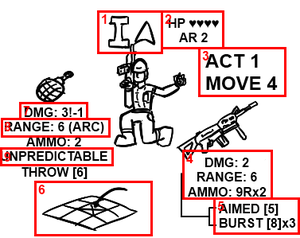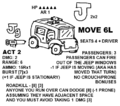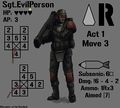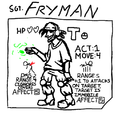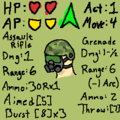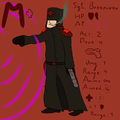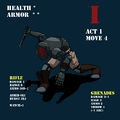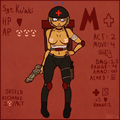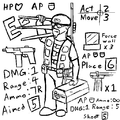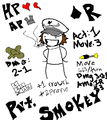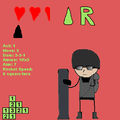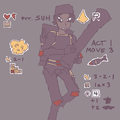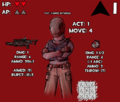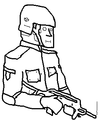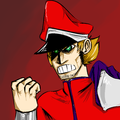Black Company: Difference between revisions
No edit summary |
No edit summary |
||
| Line 63: | Line 63: | ||
===Promotions=== | ===Promotions=== | ||
Every phase in which you submit an action and come out alive puts you further towards your next promotion. All new players start out at the Private rank, but after their first battle or two they will be promoted to Specialist and be permitted to improve one thing on their stat card. This can be nearly anything except for ACT, but is generally a single number (for instance, your MOVE, or your gun's damage or range, your HP, or lowering the goal on a dice roll). The only case where an upgrade comes at a penalty is AR, which will reduce your MOVE by 1 for each point it is raised by. | Every phase in which you submit an action and come out alive puts you further towards your next promotion. All new players start out at the Private rank, but after their first battle or two they will be promoted to Specialist and be permitted to improve one thing on their stat card. This can be nearly anything except for ACT, but is generally a single number (for instance, your MOVE, or your gun's damage or range, your HP, or lowering the goal on a dice roll). The only case where an upgrade comes at a penalty is AR, which will reduce your MOVE by 1 for each point it is raised by. | ||
====Temporary Classes==== | |||
Occasionally officers will bring support along on the mission that will require a player, such as animal handlers or tanks. While playing these temporary classes, you progress towards your next promotion as normal and will continue to upgrade your normal class. However, a character can choose to attach themselves to a support class permanently, which will allow them to upgrade that class, but they will only be able to play when that support is fielded, and will lose all promotion progress. | |||
====Spec Classes==== | |||
At the ranks of Sergeant First Class, and Command Sergeant Major, players have the opportunity to make a '''spec class'''. This is an entirely new class, that is related to the base class that the player specced out of in some way. The first spec is more moderate, but by the second spec the class is often only tangentially related to the original class. | |||
'''Examples:'''<br/> | |||
Infantry First Spec: | |||
*Shotgunner | |||
*Heavy Machinegunner | |||
*Field Tactician | |||
*Squad Leader | |||
Rocketeer First Spec: | |||
*Flamethrower | |||
*Grenade Launcher | |||
*Semtex Expert (Semtexpert?) | |||
*MANPAD | |||
Telekinetic First Spec: | |||
*Hypnotist | |||
*Clairsentient | |||
*Psychic Blademaster | |||
*Psychoporter | |||
Medic First Spec: | |||
*Knight | |||
*Combat Medic | |||
*Scientist | |||
*Scout | |||
Sniper First Spec: | |||
*Forward Observer | |||
*Autosniper | |||
*Long-Range Sniper | |||
*Archer | |||
Engineer First Spec: | |||
*Sentry Specialist | |||
*Entrenchment Specialist | |||
*Drone Engineer (Dronengineer?) | |||
*Roboticist | |||
Spec class limits are intentionally vague, so that players have freedom in class creation. | |||
===Death=== | ===Death=== | ||
| Line 85: | Line 130: | ||
==Little Rule Database== | ==Little Rule Database== | ||
This is a collection of little rules that don't fit anywhere else, and aren't mentioned on the class cards. | This is a collection of little rules that don't fit anywhere else, and aren't mentioned on the class cards. | ||
* You can shoot past normal range at a penalty of -1 to-hit for each square exceeded. | * You can shoot past normal range at a penalty of -1 to-hit for each square exceeded (on weapons with a range higher than 1). | ||
* Turrets and force walls can be picked up and moved | * Turrets and force walls can be picked up and moved for 1 ACT. | ||
* Shields and force walls will block '''all''' damage before they are destroyed. | * Shields and force walls will block '''all''' damage before they are destroyed. | ||
* The engineer and his allies can shoot through allied force walls. This applies for enemies and their force walls too. | * The engineer and his allies can shoot through allied force walls. This applies for enemies and their force walls too. | ||
| Line 94: | Line 139: | ||
* Tanks are considered armor for their pilots. | * Tanks are considered armor for their pilots. | ||
* Telekinetics cannot Lift vehicles. | * Telekinetics cannot Lift vehicles. | ||
* You can move through friendly units, but not stand on top of them. | |||
* Diagonals are identical to cardinal directions for the purposes of movement and range. | |||
* Blue circles are civilians. | |||
==Codex and Cards== | ==Codex and Cards== | ||
Revision as of 22:42, 12 September 2012
| Black Company by Squeegy |
|---|
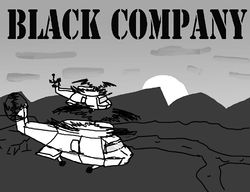
|
|
|
Black Company is a personalized, turn-based wargame where individual players join up as various classes of soldiers, and are led by their fellow suggestors in battle against GM-controlled forces in small-scale skirmishes. The enemy is commanded either by Squeegy, the author, or MrQ, also known as General Q. Waterbuffalo.
Plot
The suggestors play as members of Black Company, a division in the American military. The very first mission involved a surprise attack on a Black Company convoy by troops of the Mexican army, disguised as friendly soldiers at a checkpoint. They were slaughtered, and war sprang out between the two countries. Black Company took the fight to Zangano, the paramilitary organization that comprises the Mexican army much as Black Company comprises the United States's.
Game Progression
Much of the early fighting took place on the 4chan /tg/ board, including the initial failed mission and several missions in the first Mexican sector. /tg/ lost several battles due to poor organization, incompetent leadership and insufficient numbers. Since then, the game has been ported exclusively to tgchan, and the latest sector has been handled entirely by their forces.
Playing the Game
Each thread begins with a roll call, where all the players post their intent to play with a callsign according to their class and a name of their choice. New players may choose from the six main classes given in Codex 3, which are Infantry, Rocketeer, Telekinetic, Medic, Sniper, and Engineer. Once everyone has joined, those who have signed up as Officers (organizational and tactical support players who have no individual role in battle) are given a map with notable locations in the sector, and asked to choose which to launch an assault on. They are occasionally given support units, which players who have joined already must then be assigned to if no one steps forward to claim them. The map is then provided to the Officers, who must choose where to deploy the troops under their command, and the game begins.
Reading Stat Cards
1. This is your callsign and symbol. Your callsign is what should go next to your name when you post. For example, this soldier could be '[I] Pvt. Cann N. Fodder'. This will include a number when you're on the map (e.g. [I1]). The symbol is how you appear on the map.
2. These are your unit statistics. The [I]nfantry has 4 HP and an armor rating of 2.
3. These are your map statistics. The [I]nfantry has 1 ACT point and 1 MOVE point. This means he can move 4 spaces, and then perform an action.
4. These are your weapon statistics. The [I]nfantry rifle does 2 damage per hit, up to a range of 6, and fires 9 shots before a reload is necessary, of which it has 2. You can fire beyond your range for a penalty of -1 to-hit for each square exceeded.
5. These are your rolls. You can roll an aimed shot, which requires you to roll 5 or higher to hit, or 3 burst shots, which each require 8 or higher to hit. Each shot is rolled on a d10. Anything marked with a roll requires 1 ACT to do.
6. This is an area of effect map. It shows that the grenade damages those in a 3x3 area around where it detonates, which is marked by an X.
7. This statistic shows that multiple damage values can result from this weapon. The exclamation point next to the 3 denotes that it is the maximum, and only those hit point-blank by the blast will take that much. All those in the surrounding squares will take only 1. Most splash damage weapons will have damage maps on the card.
8. This range has a note on it that signifies special conditions.
9. Sometimes weapons or abilities will have notes that clarify their functions.
Turns
Turns in Black Company are split into Action Phase, the phase in which all troops must submit their actions, and Enemy Phase, the phase in which allied actions resolve and the enemy then makes its movements and actions. Once you have submitted an action, you are not allowed to delete or change it, though if you failed to include a roll you may do so in another post.
Each phase represents a nebulous amount of time from how long it takes to aim and fire an assault rifle, to the time it takes to sprint down a city block. In general, battles are over in minutes.
Movement on the Map
Every class has a statistic called 'MOVE', which represents the amount of squares of movement that class can travel in one phase. For instance, the Infantry class has 4 MOVE, which means that they can move 4 squares every turn before committing an action. Notable movement rules:
- You cannot move after acting.
- One ACT can be spent to regain full MOVE, with a penalty of 1 MOVE for each ACT spent after the first. If a class has 2 ACT and 4 MOVE, they can sprint for a maximum of 11 MOVE.
- Even classes which normally must choose between moving and acting (i.e. the Sniper) can spend their act to sprint.
- Sprinting is considered a general term for moving faster, so the MOVE gained can be used while prone or crouched, for pose changes, and for any other normal expenditure of MOVE. This also means that vehicles can 'sprint'.
- Changing poses costs MOVE, but can have benefits as well as disadvantages. Each pose change costs 1 MOVE, and changing from standing to prone or vice versa requires 2, because you must crouch first.
- Crouching: +1 to-hit, -1 move, -1 to be hit (if on a hill)
- Prone +1 to-hit, -2 move, -1 to be hit (unless on lower ground, then +1 to be hit)
ACT and Actions
Any number enclosed in brackets on a class card (for instance, 'Shoot [5]'), signifies that it is an action, that unless otherwise stated, requires the expenditure of an ACT. You must also roll to successfully complete the action, on a 1d10, with the goal of getting the number stated or higher. If you fail an action, the author decides what happens. You will never shoot an ally with a bullet unless disoriented, but explosives are unpredictable.
Damage and Armor Rating
The damage of each attack is labeled on its card. In general, sidearms are Dam 1 and rifles are Dam 2. Explosives are often Dam 6 with splash radiuses with lower damages. Shotguns are Dam 3 and sniper rifles are Dam 4. These can be improved with promotions, for instance you could turn your sniper rifle into a Dam 6 anti-tank monstrosity. If your AR is zero, damage is deducted directly from your HP. Otherwise, the damage is reduced according to the AR chart (available below). If you have an AR of 3 and take 6 damage, you can look at the chart across from '6 DAM' and under '3 AR', and see that the resulting number is 4, so you will only lose 4 HP.
Promotions
Every phase in which you submit an action and come out alive puts you further towards your next promotion. All new players start out at the Private rank, but after their first battle or two they will be promoted to Specialist and be permitted to improve one thing on their stat card. This can be nearly anything except for ACT, but is generally a single number (for instance, your MOVE, or your gun's damage or range, your HP, or lowering the goal on a dice roll). The only case where an upgrade comes at a penalty is AR, which will reduce your MOVE by 1 for each point it is raised by.
Temporary Classes
Occasionally officers will bring support along on the mission that will require a player, such as animal handlers or tanks. While playing these temporary classes, you progress towards your next promotion as normal and will continue to upgrade your normal class. However, a character can choose to attach themselves to a support class permanently, which will allow them to upgrade that class, but they will only be able to play when that support is fielded, and will lose all promotion progress.
Spec Classes
At the ranks of Sergeant First Class, and Command Sergeant Major, players have the opportunity to make a spec class. This is an entirely new class, that is related to the base class that the player specced out of in some way. The first spec is more moderate, but by the second spec the class is often only tangentially related to the original class.
Examples:
Infantry First Spec:
- Shotgunner
- Heavy Machinegunner
- Field Tactician
- Squad Leader
Rocketeer First Spec:
- Flamethrower
- Grenade Launcher
- Semtex Expert (Semtexpert?)
- MANPAD
Telekinetic First Spec:
- Hypnotist
- Clairsentient
- Psychic Blademaster
- Psychoporter
Medic First Spec:
- Knight
- Combat Medic
- Scientist
- Scout
Sniper First Spec:
- Forward Observer
- Autosniper
- Long-Range Sniper
- Archer
Engineer First Spec:
- Sentry Specialist
- Entrenchment Specialist
- Drone Engineer (Dronengineer?)
- Roboticist
Spec class limits are intentionally vague, so that players have freedom in class creation.
Death
Death is permanent in Black Company. Your character's promotion progress will be lost and their death will be mourned ICly. A soldier dies when he reaches 0 HP, and spends 3 turns in this state without being stabilized. Characters who reach 0 HP can be healed by a Medic to get them back on their feet.
Retcons
If your action or movement is misinterpreted or unjustifiably skipped by the author, you will be awarded a retcon, which you can use to undo any one event. Most commonly, this will be the event that earned you the retcon, but if you decided it's not important you can save it for literally anything that involves you (for instance, the bad roll that got you killed!).
Playing as an Officer
The Officer Corps is the organizational branch of Black Company, and has no physical presence on the battlefield. They handle deployment, tactics and strategy, tactical support, answer the questions of the enlisted men, and are responsible for submitting actions for anyone who fails to get them in by the deadline. As a result of all this, being an officer can be a lot of work, as they are the most important class in the game. Missions have been won and lost based on the competency of their officers alone.
Delegating Responsibilites
As an officer, you will be easily overwhelmed if you try and take every duty on by yourself. Tracking who has moved and who hasn't, the results of their actions, planning tactics for the phase, and worrying about enemies or hazards you can't see all by yourself is an intimidating prospect. For this reason, even though you get all the benefits of having officers with only one, it's much more convenient to have multiple officers. Then you can delegate responsibilities on the battlefield amongst yourself, and only have to worry about one section of the battlefield or one aspect of the fight while still being able to communicate for an overall picture.
As a lone officer, it's still a good idea to delegate some of those responsibilities among the enlisted men. If you divide them into squads, you might consider assigning squad leaders, whose job it is to keep track of movements among their own squad and report back to you. Any delegation of responsibility can make things much easier on you.
Playing as a Soldier
As a soldier, you have a duty to follow your officer's instructions, but strictly speaking, you don't have to. Often times the officer will give a general plan rather than ordering soldiers specifically, and it is your responsibility to interpret those orders in your action. There's a reason you submit your action directly.
[TODO: Add in strategy guides for each class.]
Little Rule Database
This is a collection of little rules that don't fit anywhere else, and aren't mentioned on the class cards.
- You can shoot past normal range at a penalty of -1 to-hit for each square exceeded (on weapons with a range higher than 1).
- Turrets and force walls can be picked up and moved for 1 ACT.
- Shields and force walls will block all damage before they are destroyed.
- The engineer and his allies can shoot through allied force walls. This applies for enemies and their force walls too.
- You are allowed to create as many characters as you like, however no two can be in the same battle at once.
- Arc: Any weapon marked with (Arc) can be arced to ignore cover at a -1 range and -1 to-hit penalty.
- Subsonic: Any weapon with a subsonic range moves the given number of squares per phase.
- Tanks are considered armor for their pilots.
- Telekinetics cannot Lift vehicles.
- You can move through friendly units, but not stand on top of them.
- Diagonals are identical to cardinal directions for the purposes of movement and range.
- Blue circles are civilians.
Codex and Cards
Custom Cards
Fanart
| Quests by Samuel |
|
Active: Completed: Prototype | Moulder's Journey Dormant: Venturing Underground | Decisions | StealthQuest | Cast Quest | Does This Thing Work | Phantom Star | Red Tape | Zalgo Quest | Kzeytch | Rat Quest | Sunken Stars | Psychogenic | Edge of the Void | Domicile | Puzzle Dungeon | Black Company | The Unkindness of Ravens | Age of Shadows Other notable creations: TGMUD | Python Strip Poker Adventures |
